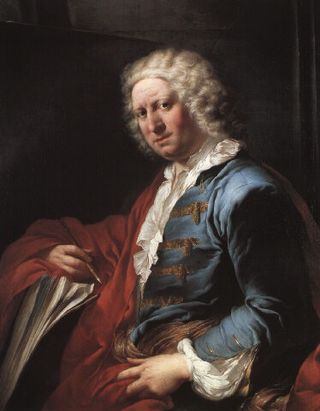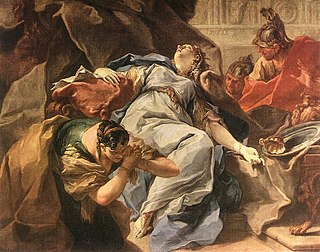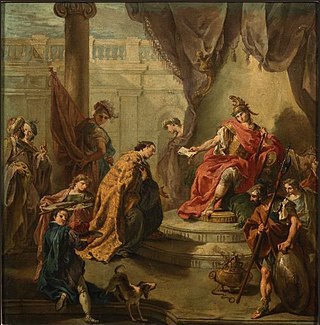Related Research Articles

Antonio Allegri da Correggio, usually known as just Correggio, was the foremost painter of the Parma school of the High Italian Renaissance, who was responsible for some of the most vigorous and sensuous works of the sixteenth century. In his use of dynamic composition, illusionistic perspective and dramatic foreshortening, Correggio prefigured the Baroque art of the seventeenth century and the Rococo art of the eighteenth century. He is considered a master of chiaroscuro.

Annibale Carracci was an Italian painter and instructor, active in Bologna and later in Rome. Along with his brother and cousin, Annibale was one of the progenitors, if not founders of a leading strand of the Baroque style, borrowing from styles from both north and south of their native city, and aspiring for a return to classical monumentality, but adding a more vital dynamism. Painters working under Annibale at the gallery of the Palazzo Farnese would be highly influential in Roman painting for decades.

Lorenzo Lotto was an Italian painter, draughtsman, and illustrator, traditionally placed in the Venetian school, though much of his career was spent in other north Italian cities. He painted mainly altarpieces, religious subjects and portraits. He was active during the High Renaissance and the first half of the Mannerist period, but his work maintained a generally similar High Renaissance style throughout his career, although his nervous and eccentric posings and distortions represented a transitional stage to the Florentine and Roman Mannerists.

Giovanni Paolo, also known as Gian Paolo Panini or Pannini, was an Italian painter and architect who worked in Rome and is primarily known as one of the vedutisti. As a painter, Panini is best known for his vistas of Rome, in which he took a particular interest in the city's antiquities. Among his most famous works are his view of the interior of the Pantheon, and his vedute—paintings of picture galleries containing views of Rome. Most of his works, especially those of ruins, have a fanciful and unreal embellishment characteristic of capriccio themes. In this they resemble the capricci of Marco Ricci. Panini also painted portraits, including one of Pope Benedict XIV.

Domenico di Pace Beccafumi was an Italian Renaissance-Mannerist painter active predominantly in Siena. He is considered one of the last undiluted representatives of the Sienese school of painting.

Pietro Longhi was a Venetian painter of contemporary genre scenes of life.

The Gallerie dell'Accademia is a museum gallery of pre-19th-century art in Venice, northern Italy. It is housed in the Scuola della Carità on the south bank of the Grand Canal, within the sestiere of Dorsoduro. It was originally the gallery of the Accademia di Belle Arti di Venezia, the art academy of Venice, from which it became independent in 1879, and for which the Ponte dell'Accademia and the Accademia boat landing station for the vaporetto water bus are named. The two institutions remained in the same building until 2004, when the art school moved to the Ospedale degli Incurabili.
Andrea Solari (1460–1524) was an Italian Renaissance painter of the Milanese school. He was initially named Andre del Gobbo, but more confusingly as Andrea del Bartolo a name shared with two other Italian painters, the 14th-century Siennese Andrea di Bartolo, and the 15th-century Florentine Andrea di Bartolo.

Giovanni Battista Cima, also called Cima da Conegliano, was an Italian Renaissance painter, who mostly worked in Venice. He can be considered part of the Venetian school, though he was also influenced by Antonello da Messina, in the emphasis he gives to landscape backgrounds and the tranquil atmosphere of his works. Once formed his style did not change greatly. He mostly painted religious subjects, often on a small scale for homes rather than churches, but also a few, mostly small, mythological ones.

Giambattista Pittoni or Giovanni Battista Pittoni was a Venetian painter of the late Baroque or Rococo period. He was among the founders of the Academy of Fine Arts of Venice, of which in 1758 he became the second president, succeeding Tiepolo.

Sebastiano Ricci was an Italian painter of the late Baroque school of Venice. About the same age as Piazzetta, and an elder contemporary of Tiepolo, he represents a late version of the vigorous and luminous Cortonesque style of grand manner fresco painting.

Giovanni Battista Piazzetta was an Italian Rococo painter of religious subjects and genre scenes.

Antonio Balestra was an Italian painter of the Rococo period.

The Diocesan museum of Brescia is a museum in Italy dedicated to the artistic patrimony of the Diocese of Brescia, and is located in the greater cloister of the Monastery of Saint Joseph in via Gasparo Salò, a short distance from the Piazza della Loggia.

The Vision of Saint Anthony of Padua or Saint Anthony with the Christ Child is an oil on canvas painting by the Italian artist Giambattista Pittoni, completed in August 1730 in Venice. It is now in the San Diego Museum of Art in California, which acquired it in 1948.

Annunciation is a c. 1757 oil on canvas painting by Giovanni Battista Pittoni, now in the Gallerie dell'Accademia in Venice.

The Death of Sophonisba is a 1716–1720 oil on canvas painting of Sophonisba by Giambattista Pittoni, produced in Venice - a sketch or smaller copy was bought by the Gemäldegalerie Alte Meister in 1723. It was bought for the Hermitage Museum in 1773 by the court cellist G. Dal Olio, then placed in the Tauride Palace. It was auctioned by Tsar Nicholas I in 1854 and bought by E.T. Zarudnoi-Cavos, then bought back by the Hermitage Museum in 1918. It was finally transferred to its present home at the Pushkin Museum in 1930. Its pair a Semiramis by the same artist, was in the Nikaelov collection in Paris before being bought by the Pushkin Museum in 1853.

The Emperor Honorius Making Constantius His Co-Ruler is an oil on canvas painting by Giambattista Pittoni from c. 1730. It has been in the Pushkin Museum, in Moscow, since 1924. It shows a rarely-painted scene from ancient Roman history in which Honorius divided his power with Constantius, husband of Honorius's sister Galla Placidia.
References
- 1 2 Alice Binion (n.d.). Pittoni, Giambattista. Grove Art Online / Oxford Art Online. Oxford: Oxford University Press. (subscription required).
- ↑ Franca Zava Boccazzi (1979). Pittoni: L'opera completa (in Italian). Venezia: Alfieri.
- ↑ Alice Binion (1983). I disegni di Giambattista Pittoni (in Italian). Firenze: La Nuova Italia.
- ↑ "Rest on the Flight into Egypt". Museo Nacional Thyssen-Bornemisza. Retrieved 28 December 2020.
- ↑ "The Virgin and Child with Saints – The Collection – Museo Nacional del Prado". www.museodelprado.es. Retrieved 28 December 2020.